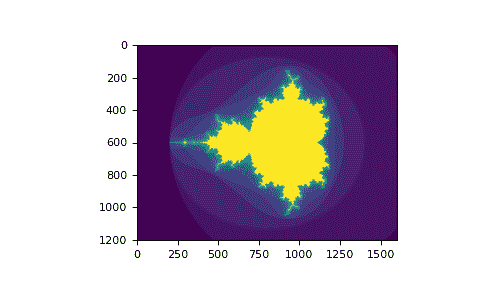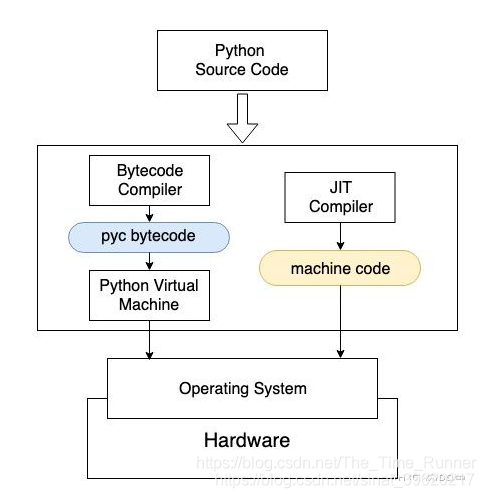用户6021899
作者相关精选
利用numba給Python代码加速 [2]
前往小程序,Get更优阅读体验!
立即前往
利用numba給Python代码加速 [2]
用户6021899
发布于 2022-01-10 00:09:09
发布于 2022-01-10 00:09:09
91700
代码可运行
举报
运行总次数:0
代码可运行

- @vectorize 装饰器
Numba 的 @vectorize 装饰器可以将以标量为输入的的python函数编译为类似Numpy的 ufuncs。创建一个传统的NumPy ufunc并不是最简单的过程,它可能需要编写一些C代码。Numba让这很容易。使用@vectorize装饰器 ,Numba可以将纯Python函数编译成ufunc,该ufunc在NumPy数组上运行的速度与用C编写的传统ufunc一样快。
一个简单的例子:
代码语言:javascript
代码运行次数:0
运行
AI代码解释
复制
import numpy as np
from numba import vectorize, float64
@vectorize(nopython=True)
def f(x, y):
return x + y
a = np.arange(1,11)
b = np.arange(10,0,-1)
print(f(a,b))以上是惰性编译,不指定参数类型。也可以采用积极编译,给出函数签名,即指定返回值和输入参数的类型。注意函数签名需写在列表中。
代码语言:javascript
代码运行次数:0
运行
AI代码解释
复制
@vectorize([float64(float64, float64)], nopython=True)
def f(x, y):
return x + y还可以指定多个函数签名,需注意越通用的类型越要排在后面。
代码语言:javascript
代码运行次数:0
运行
AI代码解释
复制
import numpy as np
from numba import vectorize, int32, int64, float32, float64
@vectorize([int32(int32, int32),
int64(int64, int64),
float32(float32, float32),
float64(float64, float64)])
def f(x, y):
return x + y此时如果传入其它类型,程序就会报错。
代码语言:javascript
代码运行次数:0
运行
AI代码解释
复制
>>> a = np.linspace(0, 1+1j, 6)
>>> f(a, a)
Traceback (most recent call last):
File "<stdin>", line 1, in <module>
TypeError: ufunc 'ufunc' not supported for the input types, and the
inputs could not be safely coerced to any supported types according
to the casting rule ''safe''代码语言:javascript
代码运行次数:0
运行
AI代码解释
复制
你可能会问,为什么不之间用@jit装饰器写一个简单的循环来替代呢?
答案是NumPy UFUNC会自动获得其他功能,如 reduce,accumulate或
广播。
a = np.arange(12).reshape(3, 4)
>>> a
array([[ 0, 1, 2, 3],
[ 4, 5, 6, 7],
[ 8, 9, 10, 11]])
>>> f.reduce(a, axis=0) # 按行求和合并
array([12, 15, 18, 21])
>>> f.reduce(a, axis=1) # 按列求和合并
array([ 6, 22, 38])
>>> f.accumulate(a) # 按行积累
array([[ 0, 1, 2, 3],
[ 4, 6, 8, 10],
[12, 15, 18, 21]])
>>> f.accumulate(a, axis=1) # 按列积累
array([[ 0, 1, 3, 6],
[ 4, 9, 15, 22],
[ 8, 17, 27, 38]])
本文参与 腾讯云自媒体同步曝光计划,分享自微信公众号。
原始发表:2022-01-06,如有侵权请联系 cloudcommunity@tencent.com 删除
本文分享自 Python可视化编程机器学习OpenCV 微信公众号,前往查看
如有侵权,请联系 cloudcommunity@tencent.com 删除。
本文参与 腾讯云自媒体同步曝光计划 ,欢迎热爱写作的你一起参与!
评论
登录后参与评论
暂无评论
登录 后参与评论
推荐阅读
编辑精选文章
换一批
《利用Python进行数据分析·第2版》 附录A NumPy高级应用A.1 ndarray对象的内部机理A.2 高级数组操作A.3 广播A.4 ufunc高级应用A.5 结构化和记录式数组A.6 更多
推荐阅读
NumPy学习笔记—(1/3)
1.5K0
numba,让你的Python飞起来!
1.2K0
numba,让你的Python飞起来!
1.3K0
灰太狼的数据世界(一)
1K0
Numba向量运算的强大
1.2K0
NumPy学习笔记(一)
6100
NumPy 1.26 中文官方指南(一)
1.3K0
4-Numpy通用函数
8720
Numpy 之ufunc运算
1.4K0
相关推荐
利用numba給Python代码加速 [1]
更多 >领券
腾讯云开发者

扫码关注腾讯云开发者
领取腾讯云代金券
Copyright © 2013 - 2025 Tencent Cloud. All Rights Reserved. 腾讯云 版权所有
深圳市腾讯计算机系统有限公司 ICP备案/许可证号:粤B2-20090059 深公网安备号 44030502008569
腾讯云计算(北京)有限责任公司 京ICP证150476号 | 京ICP备11018762号 | 京公网安备号11010802020287
Copyright © 2013 - 2025 Tencent Cloud.
All Rights Reserved. 腾讯云 版权所有
登录 后参与评论
3









